Energy Consumption and Greenhouse Gas Emissions in Australian Hotels
VerifiedAdded on 2020/05/16
|27
|5483
|132
Project
AI Summary
This professional project investigates the correlation between energy consumption and greenhouse gas emissions within the Australian hotel industry. The study begins with an introduction outlining the background, aim, objectives, and research questions. A comprehensive literature review explores theoretical backgrounds, energy consumption in buildings, and the impact of greenhouse gases. The research methodology details the approach, data collection processes, and methods employed. The data analysis reveals the consumption of energy by fuel, correlation analyses for electricity and natural gas consumption with greenhouse gas emissions, and the use of electricity and natural gas shares. The project concludes with findings, limitations, and recommendations for mitigating environmental impact. The analysis covers the period from 1999 to 2020, providing a detailed assessment of energy usage and its environmental consequences in the Australian hotel sector.
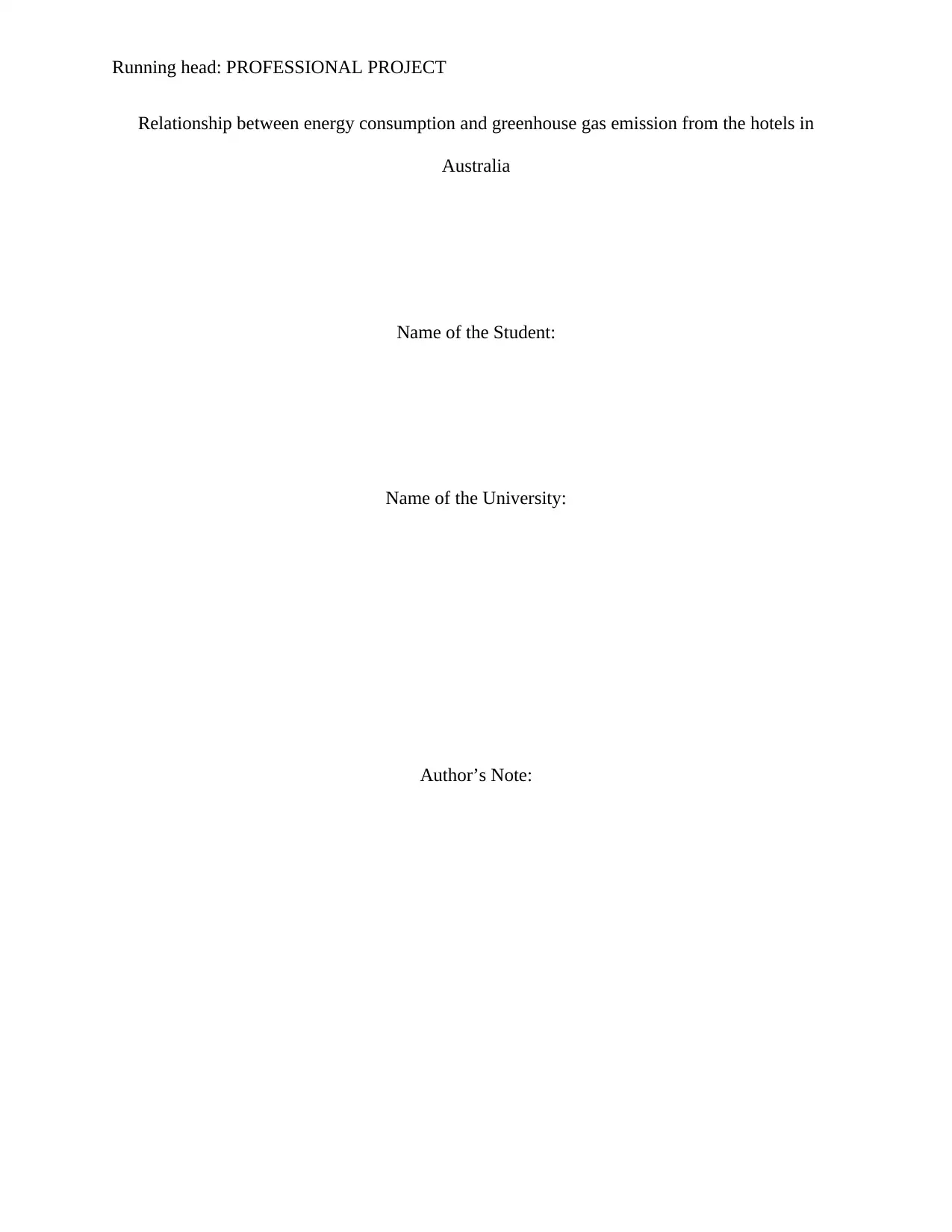
Running head: PROFESSIONAL PROJECT
Relationship between energy consumption and greenhouse gas emission from the hotels in
Australia
Name of the Student:
Name of the University:
Author’s Note:
Relationship between energy consumption and greenhouse gas emission from the hotels in
Australia
Name of the Student:
Name of the University:
Author’s Note:
Paraphrase This Document
Need a fresh take? Get an instant paraphrase of this document with our AI Paraphraser
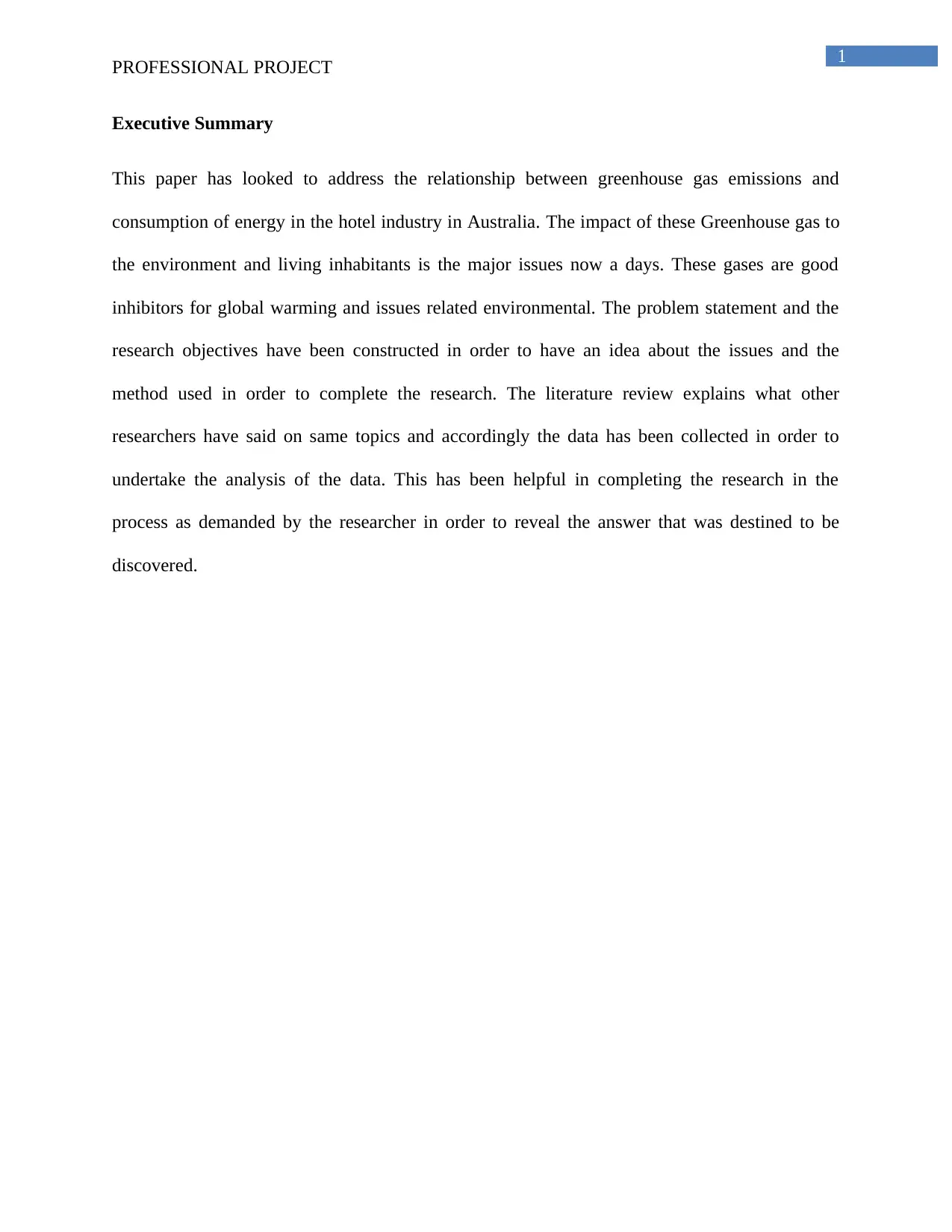
1
PROFESSIONAL PROJECT
Executive Summary
This paper has looked to address the relationship between greenhouse gas emissions and
consumption of energy in the hotel industry in Australia. The impact of these Greenhouse gas to
the environment and living inhabitants is the major issues now a days. These gases are good
inhibitors for global warming and issues related environmental. The problem statement and the
research objectives have been constructed in order to have an idea about the issues and the
method used in order to complete the research. The literature review explains what other
researchers have said on same topics and accordingly the data has been collected in order to
undertake the analysis of the data. This has been helpful in completing the research in the
process as demanded by the researcher in order to reveal the answer that was destined to be
discovered.
PROFESSIONAL PROJECT
Executive Summary
This paper has looked to address the relationship between greenhouse gas emissions and
consumption of energy in the hotel industry in Australia. The impact of these Greenhouse gas to
the environment and living inhabitants is the major issues now a days. These gases are good
inhibitors for global warming and issues related environmental. The problem statement and the
research objectives have been constructed in order to have an idea about the issues and the
method used in order to complete the research. The literature review explains what other
researchers have said on same topics and accordingly the data has been collected in order to
undertake the analysis of the data. This has been helpful in completing the research in the
process as demanded by the researcher in order to reveal the answer that was destined to be
discovered.
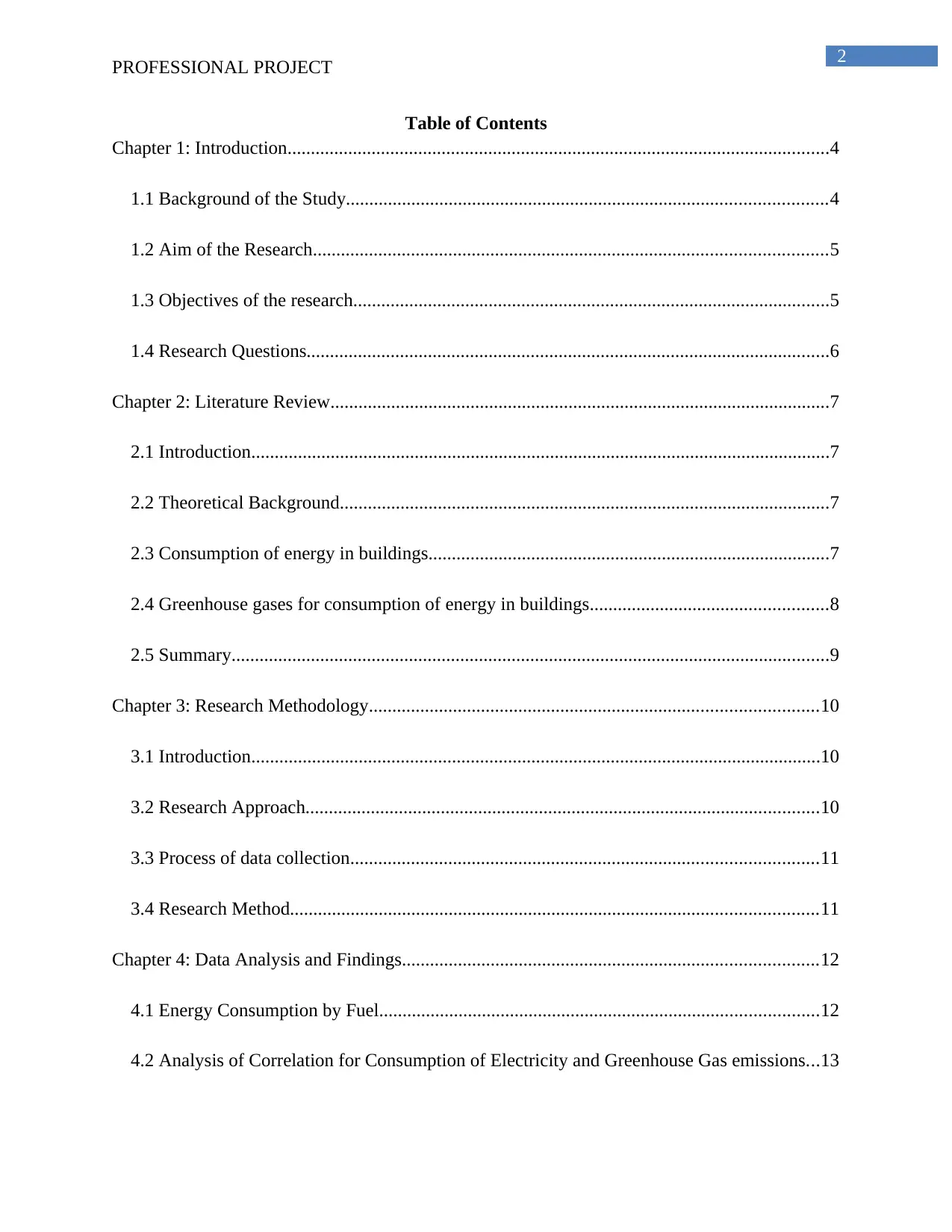
2
PROFESSIONAL PROJECT
Table of Contents
Chapter 1: Introduction....................................................................................................................4
1.1 Background of the Study.......................................................................................................4
1.2 Aim of the Research..............................................................................................................5
1.3 Objectives of the research......................................................................................................5
1.4 Research Questions................................................................................................................6
Chapter 2: Literature Review...........................................................................................................7
2.1 Introduction............................................................................................................................7
2.2 Theoretical Background.........................................................................................................7
2.3 Consumption of energy in buildings......................................................................................7
2.4 Greenhouse gases for consumption of energy in buildings...................................................8
2.5 Summary................................................................................................................................9
Chapter 3: Research Methodology................................................................................................10
3.1 Introduction..........................................................................................................................10
3.2 Research Approach..............................................................................................................10
3.3 Process of data collection....................................................................................................11
3.4 Research Method.................................................................................................................11
Chapter 4: Data Analysis and Findings.........................................................................................12
4.1 Energy Consumption by Fuel..............................................................................................12
4.2 Analysis of Correlation for Consumption of Electricity and Greenhouse Gas emissions...13
PROFESSIONAL PROJECT
Table of Contents
Chapter 1: Introduction....................................................................................................................4
1.1 Background of the Study.......................................................................................................4
1.2 Aim of the Research..............................................................................................................5
1.3 Objectives of the research......................................................................................................5
1.4 Research Questions................................................................................................................6
Chapter 2: Literature Review...........................................................................................................7
2.1 Introduction............................................................................................................................7
2.2 Theoretical Background.........................................................................................................7
2.3 Consumption of energy in buildings......................................................................................7
2.4 Greenhouse gases for consumption of energy in buildings...................................................8
2.5 Summary................................................................................................................................9
Chapter 3: Research Methodology................................................................................................10
3.1 Introduction..........................................................................................................................10
3.2 Research Approach..............................................................................................................10
3.3 Process of data collection....................................................................................................11
3.4 Research Method.................................................................................................................11
Chapter 4: Data Analysis and Findings.........................................................................................12
4.1 Energy Consumption by Fuel..............................................................................................12
4.2 Analysis of Correlation for Consumption of Electricity and Greenhouse Gas emissions...13
⊘ This is a preview!⊘
Do you want full access?
Subscribe today to unlock all pages.

Trusted by 1+ million students worldwide
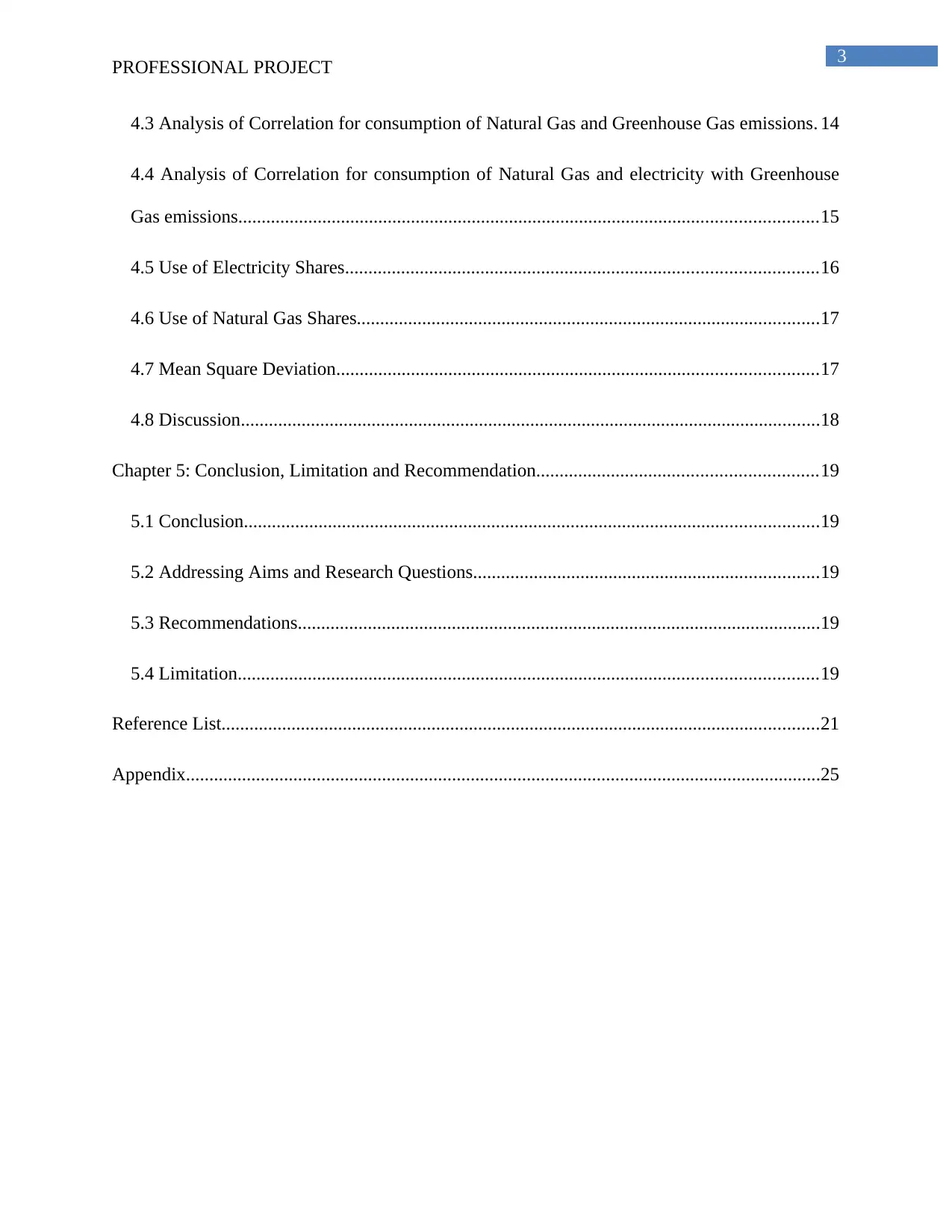
3
PROFESSIONAL PROJECT
4.3 Analysis of Correlation for consumption of Natural Gas and Greenhouse Gas emissions. 14
4.4 Analysis of Correlation for consumption of Natural Gas and electricity with Greenhouse
Gas emissions............................................................................................................................15
4.5 Use of Electricity Shares.....................................................................................................16
4.6 Use of Natural Gas Shares...................................................................................................17
4.7 Mean Square Deviation.......................................................................................................17
4.8 Discussion............................................................................................................................18
Chapter 5: Conclusion, Limitation and Recommendation............................................................19
5.1 Conclusion...........................................................................................................................19
5.2 Addressing Aims and Research Questions..........................................................................19
5.3 Recommendations................................................................................................................19
5.4 Limitation............................................................................................................................19
Reference List................................................................................................................................21
Appendix........................................................................................................................................25
PROFESSIONAL PROJECT
4.3 Analysis of Correlation for consumption of Natural Gas and Greenhouse Gas emissions. 14
4.4 Analysis of Correlation for consumption of Natural Gas and electricity with Greenhouse
Gas emissions............................................................................................................................15
4.5 Use of Electricity Shares.....................................................................................................16
4.6 Use of Natural Gas Shares...................................................................................................17
4.7 Mean Square Deviation.......................................................................................................17
4.8 Discussion............................................................................................................................18
Chapter 5: Conclusion, Limitation and Recommendation............................................................19
5.1 Conclusion...........................................................................................................................19
5.2 Addressing Aims and Research Questions..........................................................................19
5.3 Recommendations................................................................................................................19
5.4 Limitation............................................................................................................................19
Reference List................................................................................................................................21
Appendix........................................................................................................................................25
Paraphrase This Document
Need a fresh take? Get an instant paraphrase of this document with our AI Paraphraser
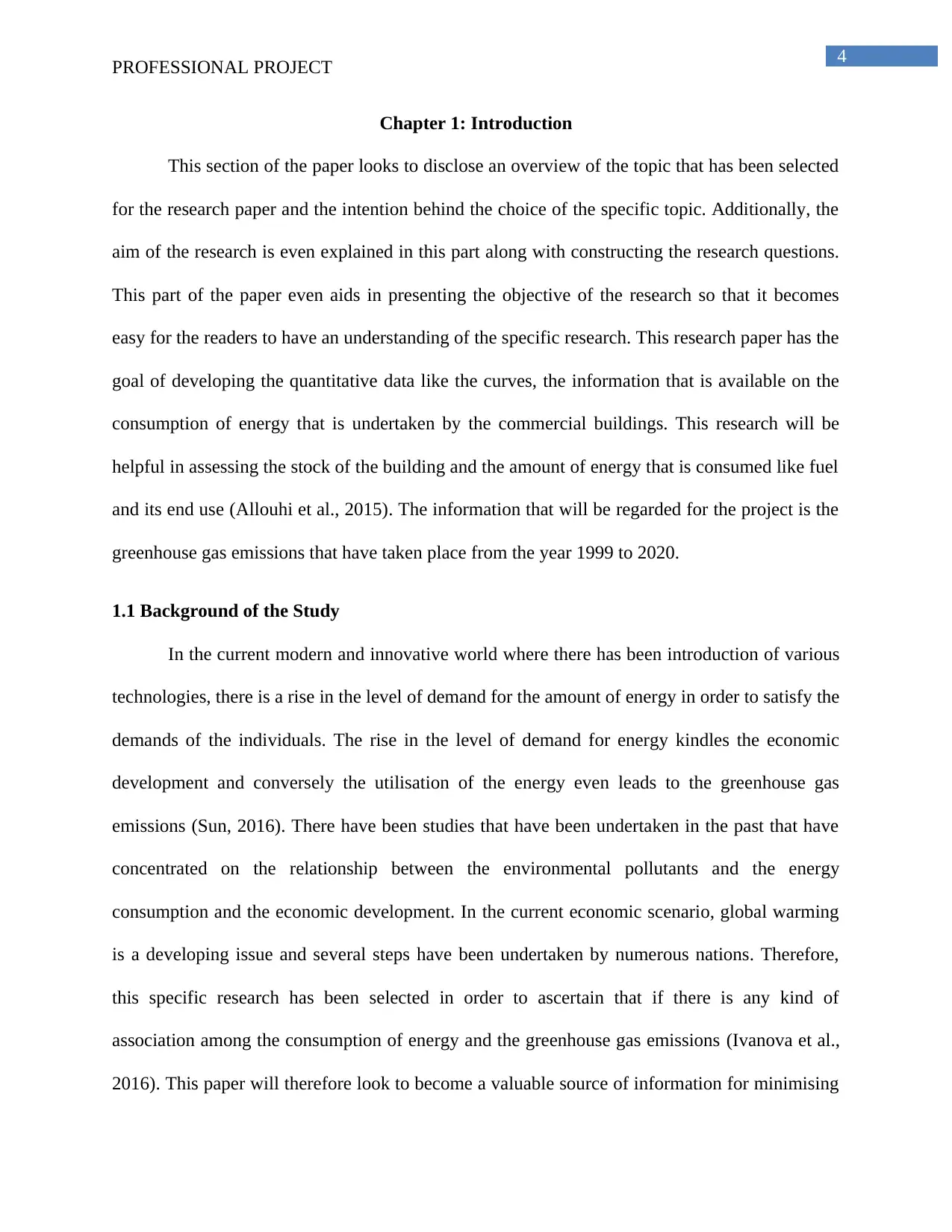
4
PROFESSIONAL PROJECT
Chapter 1: Introduction
This section of the paper looks to disclose an overview of the topic that has been selected
for the research paper and the intention behind the choice of the specific topic. Additionally, the
aim of the research is even explained in this part along with constructing the research questions.
This part of the paper even aids in presenting the objective of the research so that it becomes
easy for the readers to have an understanding of the specific research. This research paper has the
goal of developing the quantitative data like the curves, the information that is available on the
consumption of energy that is undertaken by the commercial buildings. This research will be
helpful in assessing the stock of the building and the amount of energy that is consumed like fuel
and its end use (Allouhi et al., 2015). The information that will be regarded for the project is the
greenhouse gas emissions that have taken place from the year 1999 to 2020.
1.1 Background of the Study
In the current modern and innovative world where there has been introduction of various
technologies, there is a rise in the level of demand for the amount of energy in order to satisfy the
demands of the individuals. The rise in the level of demand for energy kindles the economic
development and conversely the utilisation of the energy even leads to the greenhouse gas
emissions (Sun, 2016). There have been studies that have been undertaken in the past that have
concentrated on the relationship between the environmental pollutants and the energy
consumption and the economic development. In the current economic scenario, global warming
is a developing issue and several steps have been undertaken by numerous nations. Therefore,
this specific research has been selected in order to ascertain that if there is any kind of
association among the consumption of energy and the greenhouse gas emissions (Ivanova et al.,
2016). This paper will therefore look to become a valuable source of information for minimising
PROFESSIONAL PROJECT
Chapter 1: Introduction
This section of the paper looks to disclose an overview of the topic that has been selected
for the research paper and the intention behind the choice of the specific topic. Additionally, the
aim of the research is even explained in this part along with constructing the research questions.
This part of the paper even aids in presenting the objective of the research so that it becomes
easy for the readers to have an understanding of the specific research. This research paper has the
goal of developing the quantitative data like the curves, the information that is available on the
consumption of energy that is undertaken by the commercial buildings. This research will be
helpful in assessing the stock of the building and the amount of energy that is consumed like fuel
and its end use (Allouhi et al., 2015). The information that will be regarded for the project is the
greenhouse gas emissions that have taken place from the year 1999 to 2020.
1.1 Background of the Study
In the current modern and innovative world where there has been introduction of various
technologies, there is a rise in the level of demand for the amount of energy in order to satisfy the
demands of the individuals. The rise in the level of demand for energy kindles the economic
development and conversely the utilisation of the energy even leads to the greenhouse gas
emissions (Sun, 2016). There have been studies that have been undertaken in the past that have
concentrated on the relationship between the environmental pollutants and the energy
consumption and the economic development. In the current economic scenario, global warming
is a developing issue and several steps have been undertaken by numerous nations. Therefore,
this specific research has been selected in order to ascertain that if there is any kind of
association among the consumption of energy and the greenhouse gas emissions (Ivanova et al.,
2016). This paper will therefore look to become a valuable source of information for minimising
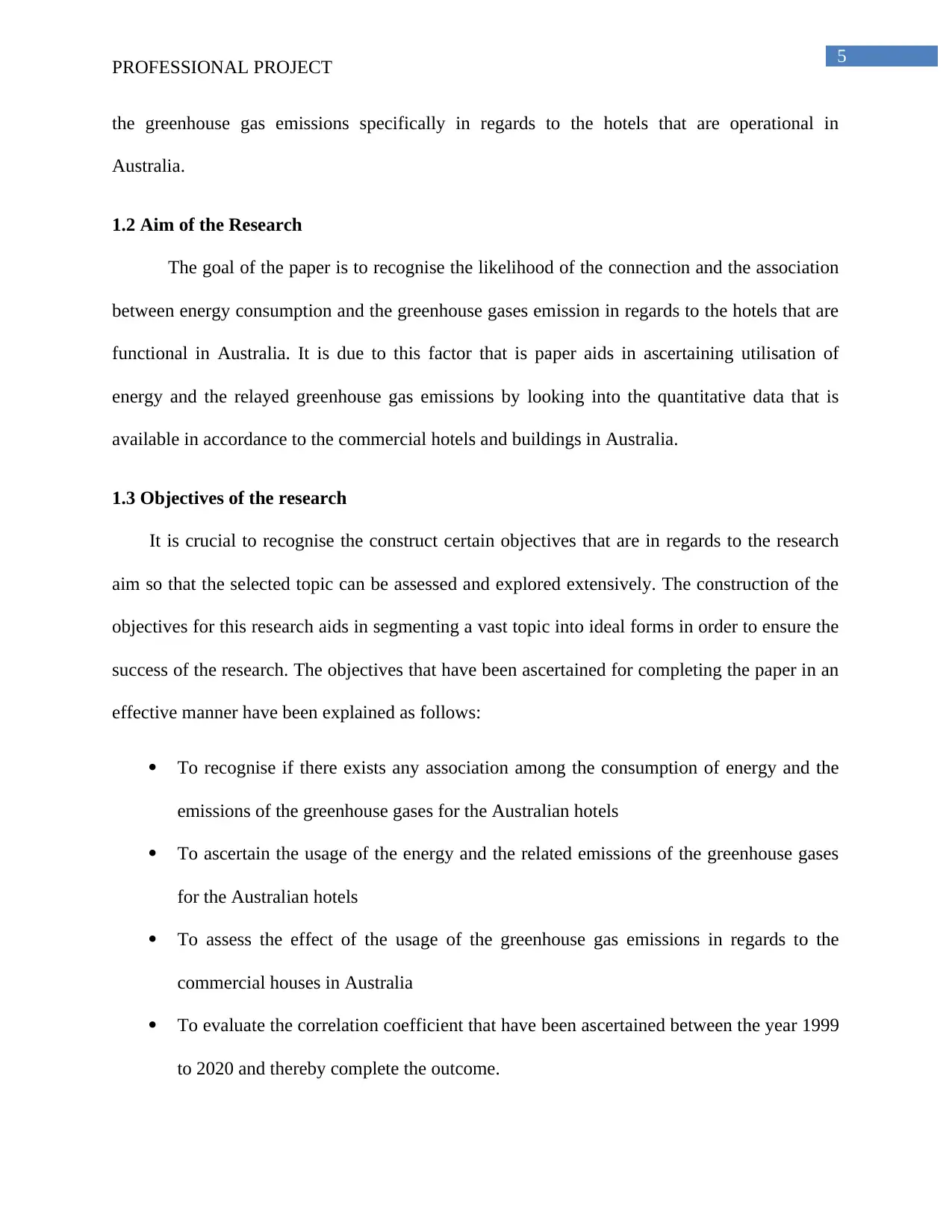
5
PROFESSIONAL PROJECT
the greenhouse gas emissions specifically in regards to the hotels that are operational in
Australia.
1.2 Aim of the Research
The goal of the paper is to recognise the likelihood of the connection and the association
between energy consumption and the greenhouse gases emission in regards to the hotels that are
functional in Australia. It is due to this factor that is paper aids in ascertaining utilisation of
energy and the relayed greenhouse gas emissions by looking into the quantitative data that is
available in accordance to the commercial hotels and buildings in Australia.
1.3 Objectives of the research
It is crucial to recognise the construct certain objectives that are in regards to the research
aim so that the selected topic can be assessed and explored extensively. The construction of the
objectives for this research aids in segmenting a vast topic into ideal forms in order to ensure the
success of the research. The objectives that have been ascertained for completing the paper in an
effective manner have been explained as follows:
To recognise if there exists any association among the consumption of energy and the
emissions of the greenhouse gases for the Australian hotels
To ascertain the usage of the energy and the related emissions of the greenhouse gases
for the Australian hotels
To assess the effect of the usage of the greenhouse gas emissions in regards to the
commercial houses in Australia
To evaluate the correlation coefficient that have been ascertained between the year 1999
to 2020 and thereby complete the outcome.
PROFESSIONAL PROJECT
the greenhouse gas emissions specifically in regards to the hotels that are operational in
Australia.
1.2 Aim of the Research
The goal of the paper is to recognise the likelihood of the connection and the association
between energy consumption and the greenhouse gases emission in regards to the hotels that are
functional in Australia. It is due to this factor that is paper aids in ascertaining utilisation of
energy and the relayed greenhouse gas emissions by looking into the quantitative data that is
available in accordance to the commercial hotels and buildings in Australia.
1.3 Objectives of the research
It is crucial to recognise the construct certain objectives that are in regards to the research
aim so that the selected topic can be assessed and explored extensively. The construction of the
objectives for this research aids in segmenting a vast topic into ideal forms in order to ensure the
success of the research. The objectives that have been ascertained for completing the paper in an
effective manner have been explained as follows:
To recognise if there exists any association among the consumption of energy and the
emissions of the greenhouse gases for the Australian hotels
To ascertain the usage of the energy and the related emissions of the greenhouse gases
for the Australian hotels
To assess the effect of the usage of the greenhouse gas emissions in regards to the
commercial houses in Australia
To evaluate the correlation coefficient that have been ascertained between the year 1999
to 2020 and thereby complete the outcome.
⊘ This is a preview!⊘
Do you want full access?
Subscribe today to unlock all pages.

Trusted by 1+ million students worldwide
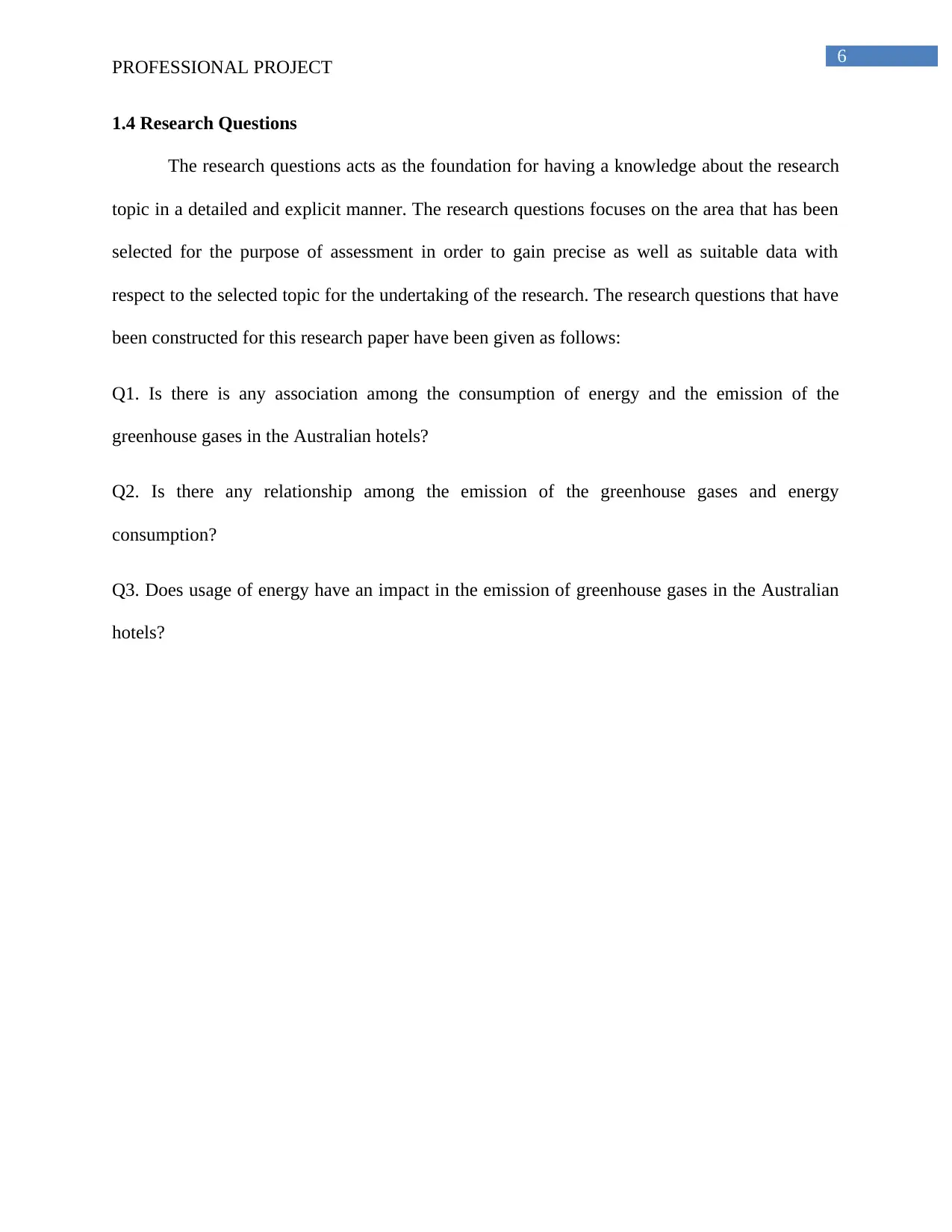
6
PROFESSIONAL PROJECT
1.4 Research Questions
The research questions acts as the foundation for having a knowledge about the research
topic in a detailed and explicit manner. The research questions focuses on the area that has been
selected for the purpose of assessment in order to gain precise as well as suitable data with
respect to the selected topic for the undertaking of the research. The research questions that have
been constructed for this research paper have been given as follows:
Q1. Is there is any association among the consumption of energy and the emission of the
greenhouse gases in the Australian hotels?
Q2. Is there any relationship among the emission of the greenhouse gases and energy
consumption?
Q3. Does usage of energy have an impact in the emission of greenhouse gases in the Australian
hotels?
PROFESSIONAL PROJECT
1.4 Research Questions
The research questions acts as the foundation for having a knowledge about the research
topic in a detailed and explicit manner. The research questions focuses on the area that has been
selected for the purpose of assessment in order to gain precise as well as suitable data with
respect to the selected topic for the undertaking of the research. The research questions that have
been constructed for this research paper have been given as follows:
Q1. Is there is any association among the consumption of energy and the emission of the
greenhouse gases in the Australian hotels?
Q2. Is there any relationship among the emission of the greenhouse gases and energy
consumption?
Q3. Does usage of energy have an impact in the emission of greenhouse gases in the Australian
hotels?
Paraphrase This Document
Need a fresh take? Get an instant paraphrase of this document with our AI Paraphraser
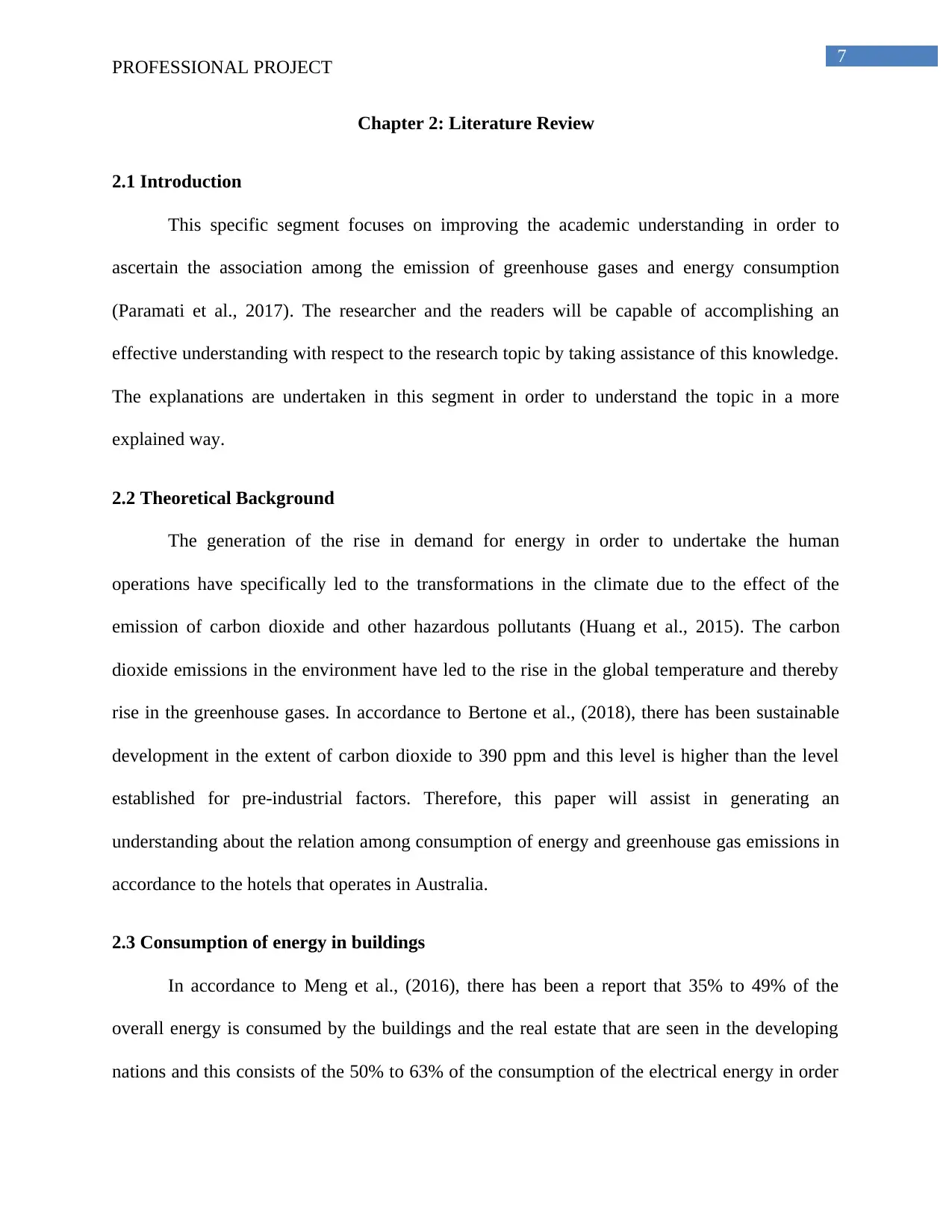
7
PROFESSIONAL PROJECT
Chapter 2: Literature Review
2.1 Introduction
This specific segment focuses on improving the academic understanding in order to
ascertain the association among the emission of greenhouse gases and energy consumption
(Paramati et al., 2017). The researcher and the readers will be capable of accomplishing an
effective understanding with respect to the research topic by taking assistance of this knowledge.
The explanations are undertaken in this segment in order to understand the topic in a more
explained way.
2.2 Theoretical Background
The generation of the rise in demand for energy in order to undertake the human
operations have specifically led to the transformations in the climate due to the effect of the
emission of carbon dioxide and other hazardous pollutants (Huang et al., 2015). The carbon
dioxide emissions in the environment have led to the rise in the global temperature and thereby
rise in the greenhouse gases. In accordance to Bertone et al., (2018), there has been sustainable
development in the extent of carbon dioxide to 390 ppm and this level is higher than the level
established for pre-industrial factors. Therefore, this paper will assist in generating an
understanding about the relation among consumption of energy and greenhouse gas emissions in
accordance to the hotels that operates in Australia.
2.3 Consumption of energy in buildings
In accordance to Meng et al., (2016), there has been a report that 35% to 49% of the
overall energy is consumed by the buildings and the real estate that are seen in the developing
nations and this consists of the 50% to 63% of the consumption of the electrical energy in order
PROFESSIONAL PROJECT
Chapter 2: Literature Review
2.1 Introduction
This specific segment focuses on improving the academic understanding in order to
ascertain the association among the emission of greenhouse gases and energy consumption
(Paramati et al., 2017). The researcher and the readers will be capable of accomplishing an
effective understanding with respect to the research topic by taking assistance of this knowledge.
The explanations are undertaken in this segment in order to understand the topic in a more
explained way.
2.2 Theoretical Background
The generation of the rise in demand for energy in order to undertake the human
operations have specifically led to the transformations in the climate due to the effect of the
emission of carbon dioxide and other hazardous pollutants (Huang et al., 2015). The carbon
dioxide emissions in the environment have led to the rise in the global temperature and thereby
rise in the greenhouse gases. In accordance to Bertone et al., (2018), there has been sustainable
development in the extent of carbon dioxide to 390 ppm and this level is higher than the level
established for pre-industrial factors. Therefore, this paper will assist in generating an
understanding about the relation among consumption of energy and greenhouse gas emissions in
accordance to the hotels that operates in Australia.
2.3 Consumption of energy in buildings
In accordance to Meng et al., (2016), there has been a report that 35% to 49% of the
overall energy is consumed by the buildings and the real estate that are seen in the developing
nations and this consists of the 50% to 63% of the consumption of the electrical energy in order
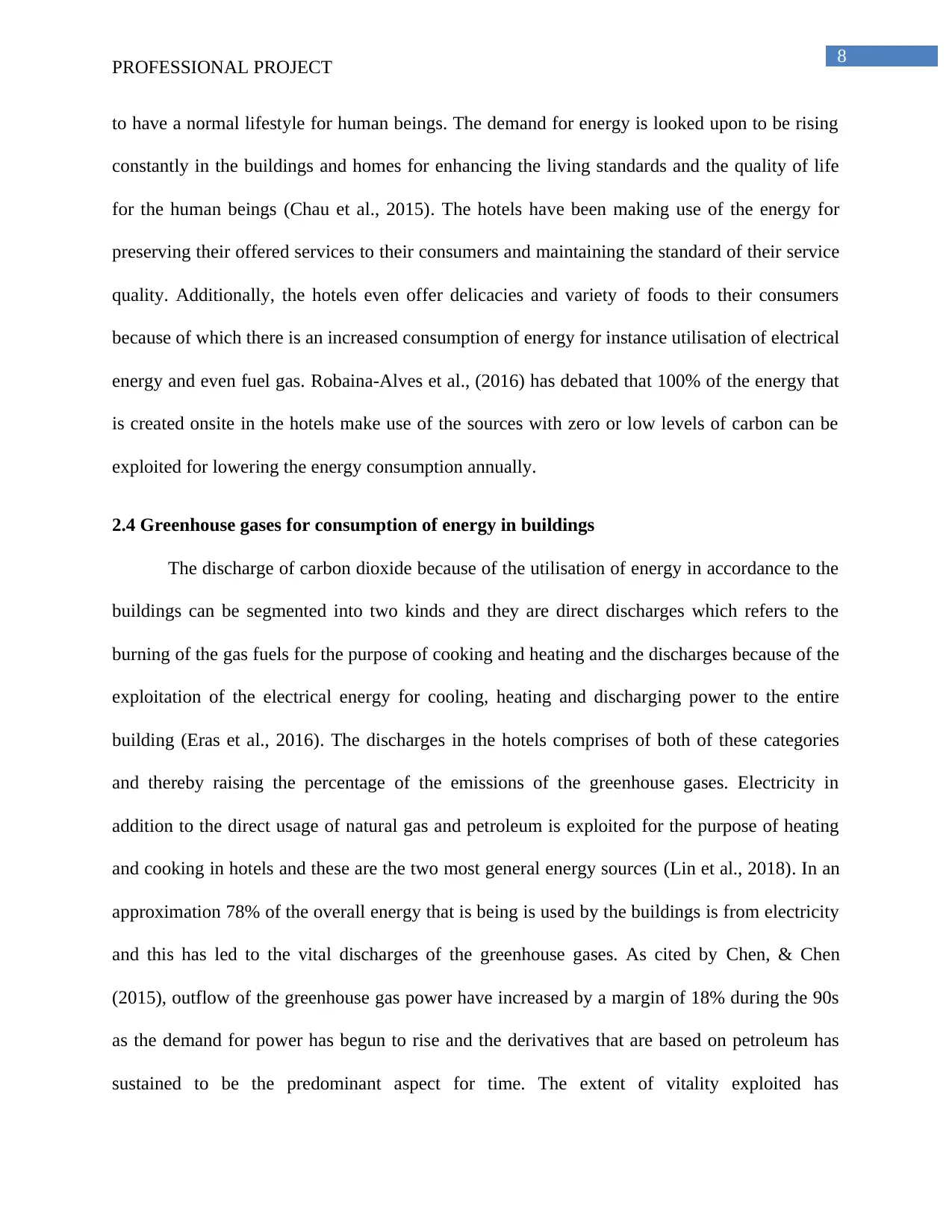
8
PROFESSIONAL PROJECT
to have a normal lifestyle for human beings. The demand for energy is looked upon to be rising
constantly in the buildings and homes for enhancing the living standards and the quality of life
for the human beings (Chau et al., 2015). The hotels have been making use of the energy for
preserving their offered services to their consumers and maintaining the standard of their service
quality. Additionally, the hotels even offer delicacies and variety of foods to their consumers
because of which there is an increased consumption of energy for instance utilisation of electrical
energy and even fuel gas. Robaina-Alves et al., (2016) has debated that 100% of the energy that
is created onsite in the hotels make use of the sources with zero or low levels of carbon can be
exploited for lowering the energy consumption annually.
2.4 Greenhouse gases for consumption of energy in buildings
The discharge of carbon dioxide because of the utilisation of energy in accordance to the
buildings can be segmented into two kinds and they are direct discharges which refers to the
burning of the gas fuels for the purpose of cooking and heating and the discharges because of the
exploitation of the electrical energy for cooling, heating and discharging power to the entire
building (Eras et al., 2016). The discharges in the hotels comprises of both of these categories
and thereby raising the percentage of the emissions of the greenhouse gases. Electricity in
addition to the direct usage of natural gas and petroleum is exploited for the purpose of heating
and cooking in hotels and these are the two most general energy sources (Lin et al., 2018). In an
approximation 78% of the overall energy that is being is used by the buildings is from electricity
and this has led to the vital discharges of the greenhouse gases. As cited by Chen, & Chen
(2015), outflow of the greenhouse gas power have increased by a margin of 18% during the 90s
as the demand for power has begun to rise and the derivatives that are based on petroleum has
sustained to be the predominant aspect for time. The extent of vitality exploited has
PROFESSIONAL PROJECT
to have a normal lifestyle for human beings. The demand for energy is looked upon to be rising
constantly in the buildings and homes for enhancing the living standards and the quality of life
for the human beings (Chau et al., 2015). The hotels have been making use of the energy for
preserving their offered services to their consumers and maintaining the standard of their service
quality. Additionally, the hotels even offer delicacies and variety of foods to their consumers
because of which there is an increased consumption of energy for instance utilisation of electrical
energy and even fuel gas. Robaina-Alves et al., (2016) has debated that 100% of the energy that
is created onsite in the hotels make use of the sources with zero or low levels of carbon can be
exploited for lowering the energy consumption annually.
2.4 Greenhouse gases for consumption of energy in buildings
The discharge of carbon dioxide because of the utilisation of energy in accordance to the
buildings can be segmented into two kinds and they are direct discharges which refers to the
burning of the gas fuels for the purpose of cooking and heating and the discharges because of the
exploitation of the electrical energy for cooling, heating and discharging power to the entire
building (Eras et al., 2016). The discharges in the hotels comprises of both of these categories
and thereby raising the percentage of the emissions of the greenhouse gases. Electricity in
addition to the direct usage of natural gas and petroleum is exploited for the purpose of heating
and cooking in hotels and these are the two most general energy sources (Lin et al., 2018). In an
approximation 78% of the overall energy that is being is used by the buildings is from electricity
and this has led to the vital discharges of the greenhouse gases. As cited by Chen, & Chen
(2015), outflow of the greenhouse gas power have increased by a margin of 18% during the 90s
as the demand for power has begun to rise and the derivatives that are based on petroleum has
sustained to be the predominant aspect for time. The extent of vitality exploited has
⊘ This is a preview!⊘
Do you want full access?
Subscribe today to unlock all pages.

Trusted by 1+ million students worldwide
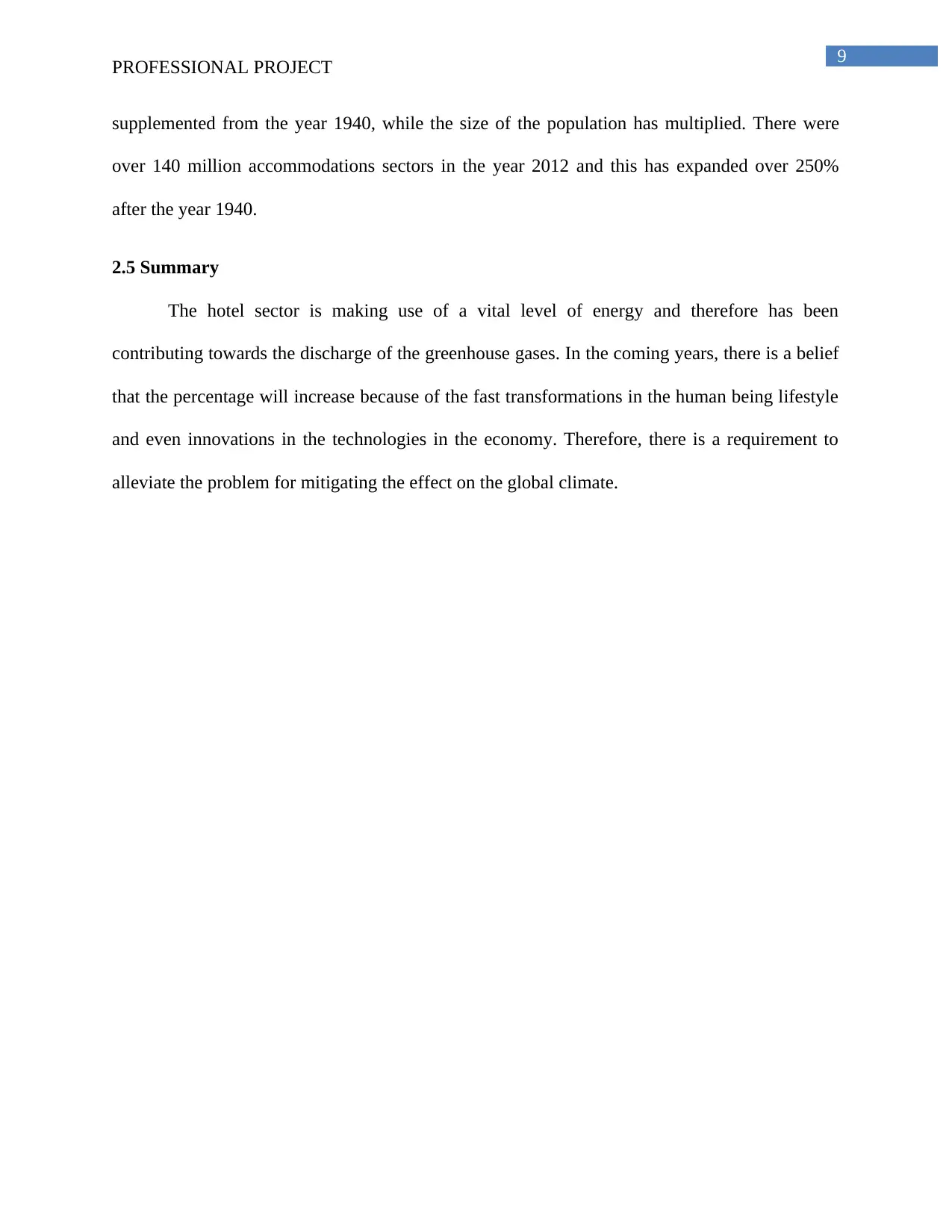
9
PROFESSIONAL PROJECT
supplemented from the year 1940, while the size of the population has multiplied. There were
over 140 million accommodations sectors in the year 2012 and this has expanded over 250%
after the year 1940.
2.5 Summary
The hotel sector is making use of a vital level of energy and therefore has been
contributing towards the discharge of the greenhouse gases. In the coming years, there is a belief
that the percentage will increase because of the fast transformations in the human being lifestyle
and even innovations in the technologies in the economy. Therefore, there is a requirement to
alleviate the problem for mitigating the effect on the global climate.
PROFESSIONAL PROJECT
supplemented from the year 1940, while the size of the population has multiplied. There were
over 140 million accommodations sectors in the year 2012 and this has expanded over 250%
after the year 1940.
2.5 Summary
The hotel sector is making use of a vital level of energy and therefore has been
contributing towards the discharge of the greenhouse gases. In the coming years, there is a belief
that the percentage will increase because of the fast transformations in the human being lifestyle
and even innovations in the technologies in the economy. Therefore, there is a requirement to
alleviate the problem for mitigating the effect on the global climate.
Paraphrase This Document
Need a fresh take? Get an instant paraphrase of this document with our AI Paraphraser
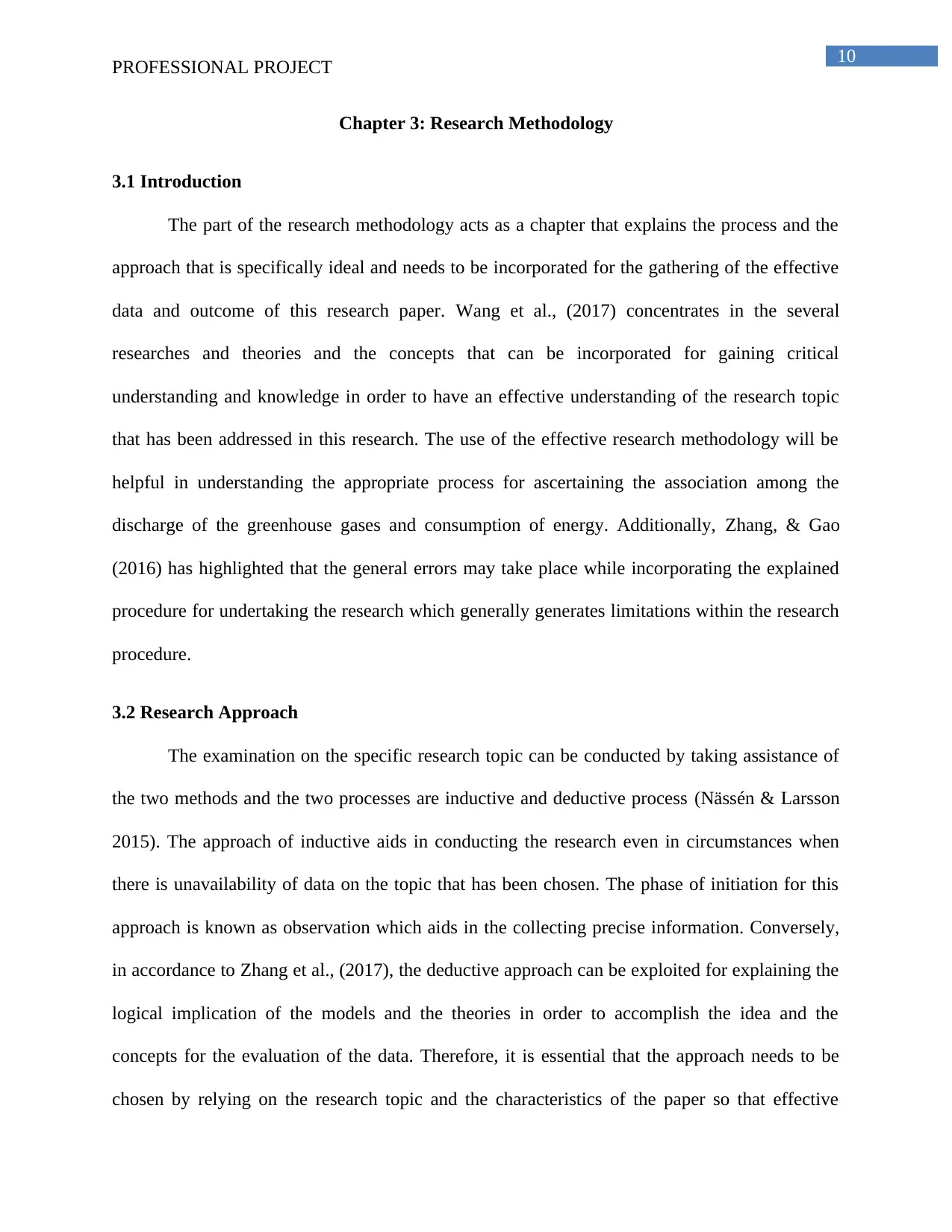
10
PROFESSIONAL PROJECT
Chapter 3: Research Methodology
3.1 Introduction
The part of the research methodology acts as a chapter that explains the process and the
approach that is specifically ideal and needs to be incorporated for the gathering of the effective
data and outcome of this research paper. Wang et al., (2017) concentrates in the several
researches and theories and the concepts that can be incorporated for gaining critical
understanding and knowledge in order to have an effective understanding of the research topic
that has been addressed in this research. The use of the effective research methodology will be
helpful in understanding the appropriate process for ascertaining the association among the
discharge of the greenhouse gases and consumption of energy. Additionally, Zhang, & Gao
(2016) has highlighted that the general errors may take place while incorporating the explained
procedure for undertaking the research which generally generates limitations within the research
procedure.
3.2 Research Approach
The examination on the specific research topic can be conducted by taking assistance of
the two methods and the two processes are inductive and deductive process (Nässén & Larsson
2015). The approach of inductive aids in conducting the research even in circumstances when
there is unavailability of data on the topic that has been chosen. The phase of initiation for this
approach is known as observation which aids in the collecting precise information. Conversely,
in accordance to Zhang et al., (2017), the deductive approach can be exploited for explaining the
logical implication of the models and the theories in order to accomplish the idea and the
concepts for the evaluation of the data. Therefore, it is essential that the approach needs to be
chosen by relying on the research topic and the characteristics of the paper so that effective
PROFESSIONAL PROJECT
Chapter 3: Research Methodology
3.1 Introduction
The part of the research methodology acts as a chapter that explains the process and the
approach that is specifically ideal and needs to be incorporated for the gathering of the effective
data and outcome of this research paper. Wang et al., (2017) concentrates in the several
researches and theories and the concepts that can be incorporated for gaining critical
understanding and knowledge in order to have an effective understanding of the research topic
that has been addressed in this research. The use of the effective research methodology will be
helpful in understanding the appropriate process for ascertaining the association among the
discharge of the greenhouse gases and consumption of energy. Additionally, Zhang, & Gao
(2016) has highlighted that the general errors may take place while incorporating the explained
procedure for undertaking the research which generally generates limitations within the research
procedure.
3.2 Research Approach
The examination on the specific research topic can be conducted by taking assistance of
the two methods and the two processes are inductive and deductive process (Nässén & Larsson
2015). The approach of inductive aids in conducting the research even in circumstances when
there is unavailability of data on the topic that has been chosen. The phase of initiation for this
approach is known as observation which aids in the collecting precise information. Conversely,
in accordance to Zhang et al., (2017), the deductive approach can be exploited for explaining the
logical implication of the models and the theories in order to accomplish the idea and the
concepts for the evaluation of the data. Therefore, it is essential that the approach needs to be
chosen by relying on the research topic and the characteristics of the paper so that effective
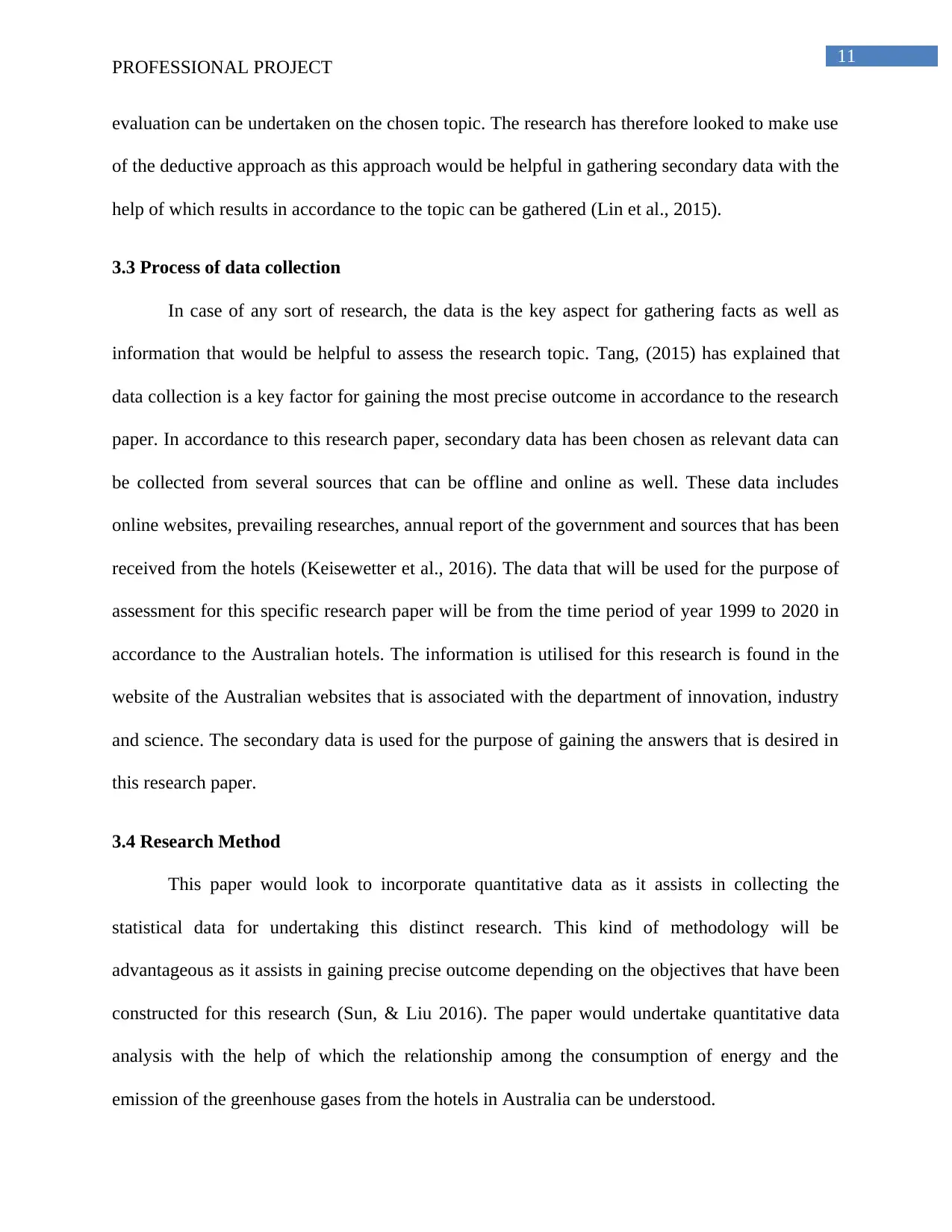
11
PROFESSIONAL PROJECT
evaluation can be undertaken on the chosen topic. The research has therefore looked to make use
of the deductive approach as this approach would be helpful in gathering secondary data with the
help of which results in accordance to the topic can be gathered (Lin et al., 2015).
3.3 Process of data collection
In case of any sort of research, the data is the key aspect for gathering facts as well as
information that would be helpful to assess the research topic. Tang, (2015) has explained that
data collection is a key factor for gaining the most precise outcome in accordance to the research
paper. In accordance to this research paper, secondary data has been chosen as relevant data can
be collected from several sources that can be offline and online as well. These data includes
online websites, prevailing researches, annual report of the government and sources that has been
received from the hotels (Keisewetter et al., 2016). The data that will be used for the purpose of
assessment for this specific research paper will be from the time period of year 1999 to 2020 in
accordance to the Australian hotels. The information is utilised for this research is found in the
website of the Australian websites that is associated with the department of innovation, industry
and science. The secondary data is used for the purpose of gaining the answers that is desired in
this research paper.
3.4 Research Method
This paper would look to incorporate quantitative data as it assists in collecting the
statistical data for undertaking this distinct research. This kind of methodology will be
advantageous as it assists in gaining precise outcome depending on the objectives that have been
constructed for this research (Sun, & Liu 2016). The paper would undertake quantitative data
analysis with the help of which the relationship among the consumption of energy and the
emission of the greenhouse gases from the hotels in Australia can be understood.
PROFESSIONAL PROJECT
evaluation can be undertaken on the chosen topic. The research has therefore looked to make use
of the deductive approach as this approach would be helpful in gathering secondary data with the
help of which results in accordance to the topic can be gathered (Lin et al., 2015).
3.3 Process of data collection
In case of any sort of research, the data is the key aspect for gathering facts as well as
information that would be helpful to assess the research topic. Tang, (2015) has explained that
data collection is a key factor for gaining the most precise outcome in accordance to the research
paper. In accordance to this research paper, secondary data has been chosen as relevant data can
be collected from several sources that can be offline and online as well. These data includes
online websites, prevailing researches, annual report of the government and sources that has been
received from the hotels (Keisewetter et al., 2016). The data that will be used for the purpose of
assessment for this specific research paper will be from the time period of year 1999 to 2020 in
accordance to the Australian hotels. The information is utilised for this research is found in the
website of the Australian websites that is associated with the department of innovation, industry
and science. The secondary data is used for the purpose of gaining the answers that is desired in
this research paper.
3.4 Research Method
This paper would look to incorporate quantitative data as it assists in collecting the
statistical data for undertaking this distinct research. This kind of methodology will be
advantageous as it assists in gaining precise outcome depending on the objectives that have been
constructed for this research (Sun, & Liu 2016). The paper would undertake quantitative data
analysis with the help of which the relationship among the consumption of energy and the
emission of the greenhouse gases from the hotels in Australia can be understood.
⊘ This is a preview!⊘
Do you want full access?
Subscribe today to unlock all pages.

Trusted by 1+ million students worldwide
1 out of 27
Related Documents
Your All-in-One AI-Powered Toolkit for Academic Success.
+13062052269
info@desklib.com
Available 24*7 on WhatsApp / Email
![[object Object]](/_next/static/media/star-bottom.7253800d.svg)
Unlock your academic potential
Copyright © 2020–2025 A2Z Services. All Rights Reserved. Developed and managed by ZUCOL.





